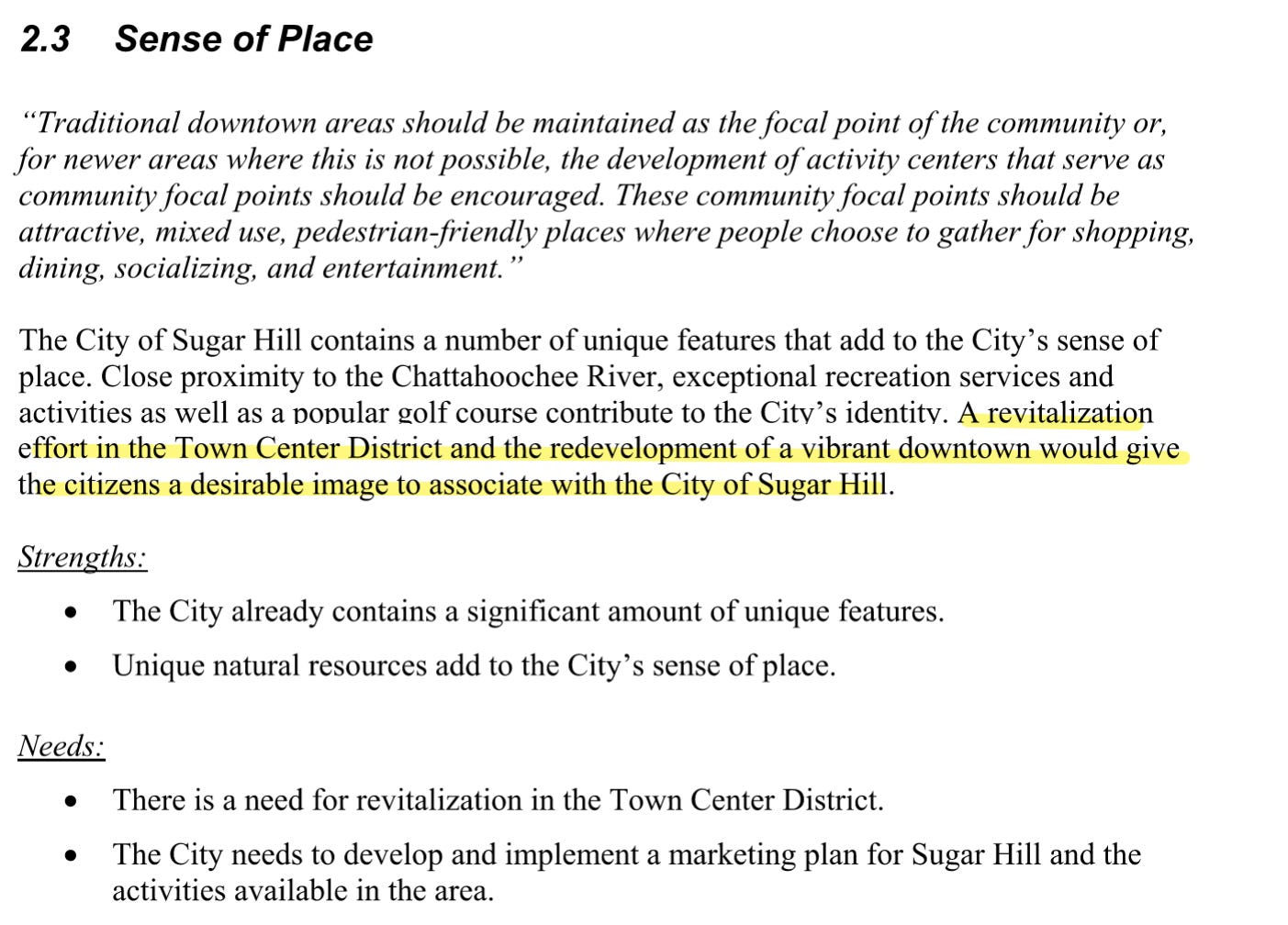Part 2 - The 2008 Comprehensive Plan
Defining the sense of place, policy objectives and an introspective look at what failure to implement the plan would mean.
Part 1 of the review of the 2008 Comprehensive Plan covered the opening sections of the plan, including the 2007 Community Assessment, introduction and future character areas. If you haven’t read it - start there and return here!
Part 2 will go through the community objectives, policy and an introspective look at what it would mean to fail to create that “sense of place” that has been a recurring theme throughout these foundation setting documents.
The next section of the plan focuses on community objectives. There are two worth highlighting. Section 2.3 - Sense of Place, since that’s been a recuring discussion point throughout and Section 2.12 - Housing Choices, since the variety of housing choices was minimal in 2008.
The Sense of Place continues to put emphasis on a vibrant downtown - creating a community focal point. It describes it as an attractive, mixed use, pedestrian-friendly place with places to shop, dine, socialize and be entertained. This follows on the Town Center District character area described in part 1 of this look at the 2008 plan.
The notable portion of Section 2.12 - Housing Choices is the selected quote. This quote is, of course, in contrast to the expressed desires of the majority regarding housing choices. However, that’s understandable given that the city was expected to grow (and did, as it had for previous 70 years of its existence).
Moving into section 4, policies, right off the bat we move into economic development. Policy is, of course, the bailiwick of Mayor and Council so it should be the primary focus of their duty to implement. As for economic development, most of the 2008 plan centered around the city’s best opportunity for economic development - downtown. And we see specifically mentioned the discouragement of strip retail.
Following on the housing policy side, the comp plan correctly predicts the future of Sugar Hill. It acknowledges that a “variety of housing options will be required”. Provide for adequate housing stock, encouraging home ownership, support pedestrian-friendly residential development, and support of mixed-use development in appropriate areas (i.e. downtown) are all admirable policy decisions that Mayors and Councils have been promoting since 2008.
In section 4.2.6 Transportation, the city took a position that, in particular in 2008 in the suburbs, was roundly anathema in prior suburban planning - consideration for movement outside of the personal vehicle.
The highlighted sentence stood in stark contrast to traditional suburban development - that the driving consideration for any form of getting around is the personal automobile. (And we wonder why we have traffic congestion…)
Does that mean the expectation is everyone walking everywhere? Of course not.
What it does acknowledge is that building your city around the automobile rather than people is a losing strategy over the long term. Automobiles are an important tool in getting around - but it’s only one tool in what should be a complete toolbox. A hammer is good for one thing only and if that’s the only tool you’ve got, you won’t be able to actually build anything.
This concluded the meat of comp plan, however, the appendices included a number of interesting parts as well.
Take, for example, this chart. Showing that the city had grew in population by 250%, which is a staggering rate of growth of 25% population increase every single year between 1990 and 2000, yet the number of people who worked in the city limits grew from just 4% to 5%.
Under “Issues and Opportunities” regarding transportation, the plan acknowledges the problem with being a suburban bedroom community - traffic congestion.
Now, let’s take a look at one last item in the 2008 comp plan - it’s perhaps the most revealing and self-reflective portion of the entire plan. The last few pages feature a publication from January 2008 called “Sugar Hill Today”. This appears to be a magazine type summary of the purpose of the plan that would have been printed and stapled in the middle.
It contains some interesting reading under the “Quality Community Objectives Analysis”, but there’s a portion that deserves to be highlighted for its bluntness - the “Sense of Place” section. It could not be more on the nose if it tried.
In particular, let’s highlight that last sentence, because it succinctly and bluntly states the importance of loving where you live:
“WITHOUT A DOWNTOWN AREA THAT HAS A LIVELY MIX OF RESTAURANTS, SHOPS AND ACTIVITIES, RESIDENTS WILL TRAVEL TO AND IDENTIFY WITH OTHER AREAS THAT DO PROVIDE THAT DESTINATION.”
The 2008 Comprehensive Plan contained a number of revelations and blunt realities that the city was facing. The plan closed its last page with a unanimous adoption of the “Community Agenda” in January 2009.
The 2008 Comprehensive Plan laid out a vision for the future of Sugar Hill as a Strong Community creating a sense of place that would allow residents to Love Where They Live.











